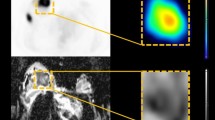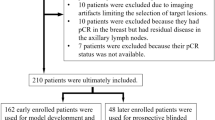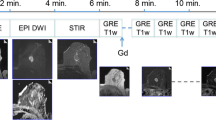Abstract
Early prediction of pathological complete response (pCR) following neoadjuvant chemotherapy (NAC) for breast cancer plays a critical role in surgical planning and optimizing treatment strategies. Recently, machine and deep-learning based methods were suggested for early pCR prediction from multi-parametric MRI (mp-MRI) data including dynamic contrast-enhanced MRI and diffusion-weighted MRI (DWI) with moderate success. We introduce PD-DWI (https://github.com/TechnionComputationalMRILab/PD-DWI), a physiologically decomposed DWI machine-learning model to predict pCR from DWI and clinical data. Our model first decomposes the raw DWI data into the various physiological cues that are influencing the DWI signal and then uses the decomposed data, in addition to clinical variables, as the input features of a radiomics-based XGBoost model. We demonstrated the added-value of our PD-DWI model over conventional machine-learning approaches for pCR prediction from mp-MRI data using the publicly available Breast Multi-parametric MRI for prediction of NAC Response (BMMR2) challenge. Our model substantially improves the area under the curve (AUC), compared to the current best result on the leaderboard (0.8849 vs. 0.8397) for the challenge test set. PD-DWI has the potential to improve prediction of pCR following NAC for breast cancer, reduce overall mp-MRI acquisition times and eliminate the need for contrast-agent injection.
Access this chapter
Tax calculation will be finalised at checkout
Purchases are for personal use only
Similar content being viewed by others
References
Baltzer, P., et al.: Diffusion-weighted imaging of the breast-a consensus and mission statement from the EUSOBI International Breast Diffusion-Weighted Imaging working group. Eur. Radiol. 30(3), 1436–1450 (2020)
Banaie, M., Soltanian-Zadeh, H., Saligheh-Rad, H.R., Gity, M.: Spatiotemporal features of DCE-MRI for breast cancer diagnosis. Comput. Methods Programs Biomed. 155 (2018). https://doi.org/10.1016/j.cmpb.2017.12.015
Bhushan, A., Gonsalves, A., Menon, J.U.: Current state of breast cancer diagnosis, treatment, and theranostics. Pharmaceutics 13 (2021). https://doi.org/10.3390/pharmaceutics13050723
Cain, E.H., Saha, A., Harowicz, M.R., Marks, J.R., Marcom, P.K., Mazurowski, M.A.: Multivariate machine learning models for prediction of pathologic response to neoadjuvant therapy in breast cancer using MRI features: a study using an independent validation set. Breast Cancer Res. Treat. 173(2), 455–463 (2018). https://doi.org/10.1007/s10549-018-4990-9
Chen, X., Chen, X., Yang, J., Li, Y., Fan, W., Yang, Z.: Combining dynamic contrast-enhanced magnetic resonance imaging and apparent diffusion coefficient maps for a radiomics nomogram to predict pathological complete response to neoadjuvant chemotherapy in breast cancer patients. J. Comput. Assisted Tomogr. 44 (2020). https://doi.org/10.1097/RCT.0000000000000978
Clark, K., et al.: The Cancer Imaging Archive (TCIA): maintaining and operating a public information repository. J. Digit. Imaging 26(6), 1045–1057 (2013). https://doi.org/10.1007/s10278-013-9622-7
Duanmu, H., et al.: Prediction of pathological complete response to neoadjuvant chemotherapy in breast cancer using deep learning with integrative imaging, molecular and demographic data. In: Martel, A.L., et al. (eds.) MICCAI 2020. LNCS, vol. 12262, pp. 242–252. Springer, Cham (2020). https://doi.org/10.1007/978-3-030-59713-9_24
Ferlay, J., et al.: Cancer statistics for the year 2020: an overview. Int. J. Cancer 149 (2021). https://doi.org/10.1002/ijc.33588
Freiman, M., Voss, S.D., Mulkern, R.V., Perez-Rossello, J.M., Callahan, M.J., Warfield, S.K.: In vivo assessment of optimal b-value range for perfusion-insensitive apparent diffusion coefficient imaging. Med. Phys. 39 (2012). https://doi.org/10.1118/1.4736516
Gao, W., Guo, N., Dong, T.: Diffusion-weighted imaging in monitoring the pathological response to neoadjuvant chemotherapy in patients with breast cancer: a meta-analysis. World J. Surgical Oncol. 16 (2018). https://doi.org/10.1186/s12957-018-1438-y
Griethuysen, J.J.V., et al.: Computational radiomics system to decode the radiographic phenotype. Cancer Res. 77 (2017). https://doi.org/10.1158/0008-5472.CAN-17-0339
Gurney-Champion, O.J., et al.: Comparison of six fit algorithms for the intra-voxel incoherent motion model of diffusion-weighted magnetic resonance imaging data of pancreatic cancer patients. PLoS ONE 13(4), e0194590 (2018)
Huang, Y., et al.: Prediction of tumor shrinkage pattern to neoadjuvant chemotherapy using a multiparametric MRI-based machine learning model in patients with breast cancer. Front. Bioeng. Biotechnol. 558 (2021)
Joo, S., et al.: Multimodal deep learning models for the prediction of pathologic response to neoadjuvant chemotherapy in breast cancer. Sci. Rep. 11(1), 1–8 (2021)
Le Bihan, D., Breton, E., Lallemand, D., Aubin, M., Vignaud, J., Laval-Jeantet, M.: Separation of diffusion and perfusion in intravoxel incoherent motion MR imaging. Radiology 168(2), 497–505 (1988)
Liang, J., et al.: Intravoxel incoherent motion diffusion-weighted imaging for quantitative differentiation of breast tumors: a meta-analysis. Front. Oncol. 10 (2020). https://doi.org/10.3389/fonc.2020.585486
Liu, Z., et al.: Radiomics of multiparametric MRI for pretreatment prediction of pathologic complete response to neoadjuvant chemotherapy in breast cancer: a multicenter study. Clin. Cancer Res. 25(12), 3538–3547 (2019)
Newitt, D.C., et al.: ACRIN 6698/I-SPY2 Breast DWI (2021). https://doi.org/10.7937/TCIA.KK02-6D95. https://wiki.cancerimagingarchive.net/x/lwH9Ag
Partridge, S.C., et al.: Diffusion-weighted MRI findings predict pathologic response in neoadjuvant treatment of breast cancer: the ACRIN 6698 multicenter trial. Radiology 289 (2018). https://doi.org/10.1148/radiol.2018180273. https://pubs.rsna.org/doi/full/10.1148/radiol.2018180273
Song, D., Man, X., Jin, M., Li, Q., Wang, H., Du, Y.: A decision-making supporting prediction method for breast cancer neoadjuvant chemotherapy. Front. Oncol. 10 (2021). https://doi.org/10.3389/fonc.2020.592556
Suo, S., et al.: J. Transl. Med. 19 (2021). https://doi.org/10.1186/s12967-021-02886-3
Woodhams, R., et al.: ADC mapping of benign and malignant breast tumors. Magn. Reson. Med. Sci. 4 (2005). https://doi.org/10.2463/mrms.4.35
Zhang, M., et al.: Multiparametric MRI model with dynamic contrast-enhanced and diffusion-weighted imaging enables breast cancer diagnosis with high accuracy. J. Magn. Reson. Imaging 49 (2019). https://doi.org/10.1002/jmri.26285
Author information
Authors and Affiliations
Corresponding author
Editor information
Editors and Affiliations
Rights and permissions
Copyright information
© 2022 The Author(s), under exclusive license to Springer Nature Switzerland AG
About this paper
Cite this paper
Gilad, M., Freiman, M. (2022). PD-DWI: Predicting Response to Neoadjuvant Chemotherapy in Invasive Breast Cancer with Physiologically-Decomposed Diffusion-Weighted MRI Machine-Learning Model. In: Wang, L., Dou, Q., Fletcher, P.T., Speidel, S., Li, S. (eds) Medical Image Computing and Computer Assisted Intervention – MICCAI 2022. MICCAI 2022. Lecture Notes in Computer Science, vol 13433. Springer, Cham. https://doi.org/10.1007/978-3-031-16437-8_4
Download citation
DOI: https://doi.org/10.1007/978-3-031-16437-8_4
Published:
Publisher Name: Springer, Cham
Print ISBN: 978-3-031-16436-1
Online ISBN: 978-3-031-16437-8
eBook Packages: Computer ScienceComputer Science (R0)





